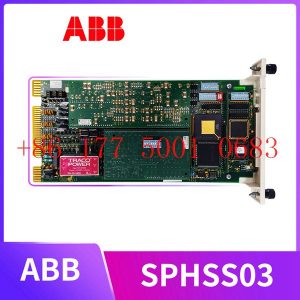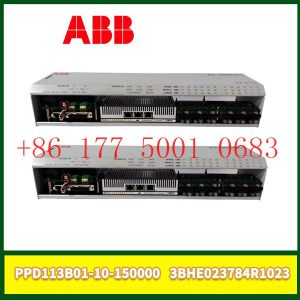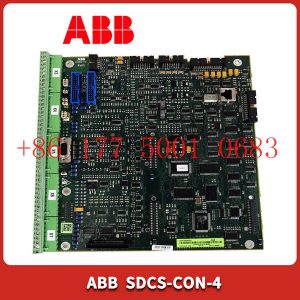Description
hardware flow control. It is an ideal choice in the field of industrial automation.
Nine Questions and Answers on Common Faults in ABB Industrial Robot Applications
Question 1: Under what circumstances do I need to back up my robot?
Answer: 1. After the new machine is powered on for the first time.
2. Before making any modifications.
3. After completing the modification.
4. If the robot is important, conduct it regularly once a week.
5. It is best to make a backup on a USB flash drive.
6. Delete old backups regularly to free up hard drive space.
Second question: What does the alarm message 10106 maintenance time reminder mean when the robot appears?
Answer: This is the intelligent periodic maintenance reminder of ABB robots.
Question 3: What should I do if the robot enters a system failure state when it is powered on?
Answer: 1. Restart the robot.
2. If it doesn”t work, check whether there is a more detailed alarm prompt on the teaching pendant and handle it.
3. Restart.
4. If it still cannot be lifted, try B startup.
5. If it still doesn’t work, try P startup.
6. If it still doesn’t work, try I startup (this will return the robot to factory settings, be careful).
Question 4: Can robot backup be shared by multiple robots?
Answer: No, for example, the backup of robot A can only be used for robot A, not robots B or C, because this will cause system failure.
Five questions: What files can be shared in the robot backup?
Answer: If the two robots are of the same model and configuration. You can share RAPID programs and EIO files, but they must be verified before they can be used normally.
Question 6: What is the mechanical origin of the robot? Where is the mechanical origin?
Answer: The six servo motors of the robot have a unique fixed mechanical origin. Incorrectly setting the mechanical origin of the robot will cause problems such
as limited movement or malfunction of the robot, the inability to walk in a straight line, etc., and serious damage to the robot.
Question 7: How to cancel the robot 50204 motion monitoring alarm?
Answer: 1. Modify the robot action monitoring parameters (control panel – action monitoring menu) to match the actual situation.
2. Use the AccSet command to reduce the robot”s acceleration.
3. Reduce the v_rot option in the speed data.
Eight questions: What should I do if the robot alarms “50296, SMB memory data difference” when it is powered on for the first time?
Answer: 1. Select calibration in the ABB main menu.
2. Click ROB_1 to enter the calibration screen and select SMB memory.
3. Select “Advanced” and click “Clear Control Cabinet Memory” after entering.
4. Click “Close” when finished, then click “Update”.
5. Select “The control cabinet or robot has been exchanged, and the control cabinet is updated using SMB memory data.”
Question 9: How to customize the speed of robot trajectory in the RAPID program?
Answer: 1. Select program data in the main menu of the teaching pendant.
2. After finding the data type Speeddata, click New.
3. Click on the initial value. The meanings of the four variables of Speeddata are: v_tcp represents the linear operating speed of the robot, v_rot
represents the rotational operating speed of the robot, v_leax represents the linear operating speed of the additional axis, v_reax represents the rotational
operating speed of the additional axis, if there is no additional axis, then No need to modify the two.
4. The customized data can be called in the RAPID program.
Excitation system ABB module 3HAC17151-1
Excitation system ABB module 3HAC17143-1
Excitation system ABB module 3HAC17142-1
Excitation system ABB module 3HAC17127-1
Excitation system ABB module 3HAC17030-3
Excitation system ABB module 3HAC17000-2
Excitation system ABB module 3HAC17000-1
Excitation system ABB module 3HAC16905-1
Excitation system ABB module 3HAC16897-1
Excitation system ABB module 3HAC16831-1
Excitation system ABB module 3HAC16797-1
Excitation system ABB module 3HAC16795-1
Excitation system ABB module 3HAC16794-1
Excitation system ABB module 3HAC16793-1
Excitation system ABB module 3HAC16790-1
Excitation system ABB module 3HAC16789-1
Excitation system ABB module 3HAC16788-1
Excitation system ABB module 3HAC16787-1
Excitation system ABB module 3HAC16786-1
Excitation system ABB module 3HAC16784-1
Excitation system ABB module 3HAC16783-1
Excitation system ABB module 3HAC16782-1
Excitation system ABB module 3HAC16780-5
Excitation system ABB module 3HAC16780-1
Excitation system ABB module 3HAC16704-7
Excitation system ABB module 3HAC16704-1
Excitation system ABB module 3HAC1670-1
Excitation system ABB module 3HAC16672-1
Excitation system ABB module 3HAC16628-3
Excitation system ABB module 3HAC16627-3
Excitation system ABB module 3HAC16626-3
Excitation system ABB module 3HAC16626-2
Excitation system ABB module 3HAC16527-1
Excitation system ABB module 3HAC16416-1
Excitation system ABB module 3HAC16403-1
Excitation system ABB module 3HAC16402-1
Excitation system ABB module 3HAC16331-1
Excitation system ABB module 3HAC16328-1
Excitation system ABB module 3HAC16327-1
Excitation system ABB module 3HAC1629-3
Excitation system ABB module 3HAC16226-1
Excitation system ABB module 3HAC16202-1
Excitation system ABB module 3HAC1618-1
Excitation system ABB module 3HAC16037-1
Excitation system ABB module 3HAC16032-3
Excitation system ABB module 3HAC16014-1/05
Excitation system ABB module 3HAC15999-1
Excitation system ABB module 3HAC15988-1
Excitation system ABB module 3HAC15944-1
Excitation system ABB module 3HAC15879-3
Excitation system ABB module 3HAC15860-1
Excitation system ABB module 3HAC15803-1
Excitation system ABB module 3HAC15734-1
Excitation system ABB module 3HAC15732-1
Excitation system ABB module 3HAC15722-1
Excitation system ABB module 3HAC15716-1









Reviews
There are no reviews yet.